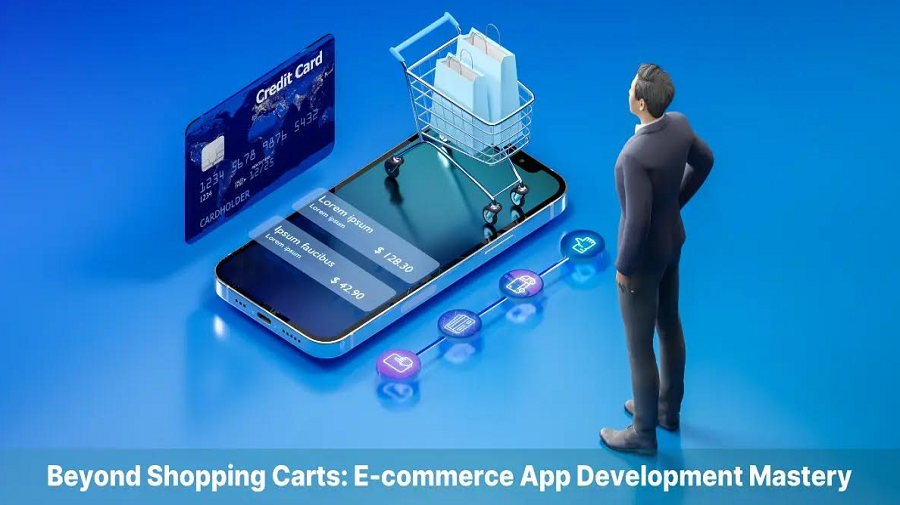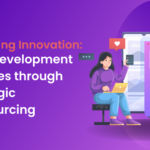Beyond Shopping Carts: E-commerce App Development Mastery

With the advent of e-commerce platforms, traditional brick-and-mortar stores have given way to vibrant online marketplaces. E-commerce app development is a key factor in today’s market that determines a company’s success. E-commerce apps are essential in this digital age because seamless and user-friendly interfaces are necessary for both buying and selling.
In this blog post, it examines the relevance of developing e-commerce apps in the present business environment. Come along on a journey through the evolution of e-commerce apps, from key development trends to essential features. Also, learn why businesses must stay on the cutting edge of technology to achieve long-term success.
Understanding the E-commerce Landscape
—————————————
Market Trends and Consumer Behavior
The rise of mobile commerce has made it a powerful force that is changing the nature of transactions. Due to the increasing prevalence of smartphones, users are conducting transactions on these devices with ease, underscoring the significance of user experiences and interfaces that are optimized for mobile.
Competitive Analysis
A thorough competitive analysis explores the major companies influencing the best e-commerce app development company market. Analyzing popular e-commerce apps yields insightful information and lessons that can guide the strategies of companies looking to succeed in this cutthroat market.
It is strategically positioning itself through an understanding of market trends, consumer behaviors, and the lessons learned from the successes of established players.
Essential Features of E-commerce Apps
—————————————
User-Friendly Design
The success of an e-commerce app depends on how user-friendly it is, with an emphasis on simple navigation to improve the overall shopping experience. Positive user experiences are enhanced by intuitive user interface (UI) features like simple product categorization, flawless search functionality, and an easy checkout procedure.
Analyzing popular e-commerce apps features such as Shopify and Amazon shows how well-designed user interface elements increase user engagement and boost conversion rates.
Personalization and User Experience (UX)
Modern e-commerce is built on personalization, where artificial intelligence and machine learning are important components. By delivering customized recommendations based on user behavior, preferences, and purchase history, these technologies improve user experience and make shopping more enjoyable.
The effects of tailored content and recommendations on user happiness and retention are demonstrated through case studies of exceptional apps like Netflix and Spotify. E-commerce apps can improve user experience, encourage customer loyalty, and ultimately stick out in a crowded market by incorporating AI-driven personalization. A pleasant and memorable online shopping experience is fostered when e-commerce apps incorporate these fundamental features, which guarantee that they not only meet but surpass user expectations.
Technical Aspects of E-commerce App Development
—————————————
Choosing the Right Technology Stack
Selecting the right technology stack is essential when developing e-commerce apps. It’s crucial to compare development frameworks like React, Angular, and Vue.js in detail. Selecting a stable server-side technology, such as Node.js, Django, or Ruby on Rails, is one of the backend considerations. Frontend factors, which emphasize user interface and experience, require selecting a framework under the needs of the application.
Security and Data Protection
When developing an e-commerce app, security is crucial. The confidentiality and integrity of user information are guaranteed by incorporating data encryption mechanisms, particularly during transactions. A strong security posture is facilitated by using secure payment gateways and adhering to industry standards for secure coding practices.
E-commerce applications need to put user privacy first, get permission after being informed, and put safeguards in place to protect user data. E-commerce apps can build trust, safeguard user data, and promote a safe environment for online transactions by fully addressing security concerns. These technical elements are essential to an e-commerce app’s performance and dependability because they guarantee that its functionality and security meet or surpass user expectations.
Integrating Advanced Features and Technologies
—————————————
Augmented Reality (AR) and Virtual Reality (VR)
The experience of shopping is revolutionized when e-commerce apps incorporate AR and VR technologies. VR produces realistic virtual storefronts that offer a distinctive and captivating retail experience.
Alibaba’s Buy+ VR shopping platform and IKEA’s AR app for furniture placement are two examples. Through the provision of a realistic product preview, these technologies not only improve user experience but also lower return rates.
Chatbots and AI Assistance
Customer support in e-commerce apps is greatly enhanced by chatbots and AI-driven help. These technologies effectively handle customer inquiries by offering prompt, tailored support. To provide personalized product recommendations that improve user engagement and increase sales, AI algorithms examine user interactions.
AI is used by e-commerce behemoths like Amazon to deliver tailored recommendations, and chatbots on social media sites like Facebook Messenger offer real-time customer support. The smooth incorporation of these cutting-edge features not only expedites the purchasing process but also creates a responsive and dynamic channel of interaction that raises user satisfaction levels and encourages repeat business.
What Are the Marketing and Monetization Strategies?
—————————————
Effective Marketing Techniques for E-commerce Apps
E-commerce app visibility must be maximized, which calls for strategic marketing initiatives. User acquisition and brand awareness can be boosted by influencer partnerships, social media campaigns, and interesting content. For an app to be visible in search engine results, it must be optimized for keywords, meta tags, and content to improve discoverability and draw in organic traffic.
Monetization Models
Selecting an appropriate monetization strategy is essential for long-term revenue production. E-commerce applications frequently use a variety of business models, such as in-app purchases and subscription services. By giving paying customers access to exclusive content or services, subscription models provide a consistent source of income.
Users can purchase extra features or products within the app through in-app purchases. Achieving a balance between monetization and user experience is crucial, though. User satisfaction may suffer if important features are only accessible through purchases or if users are inundated with advertisements.
The long-term success of the e-commerce app is influenced by the implementation of a well-balanced monetization strategy, which guarantees sustainable revenue generation while preserving a positive user experience.
Analyzing and Improving Performance
—————————————
Key Performance Indicators (KPIs)
App success depends on tracking Key Performance Indicators (KPIs). Metrics that reveal information about the performance of the app include user engagement, conversion rates, and retention.
Continuous Improvement and Updates
Updating the app frequently in response to user feedback keeps it competitive and relevant. Analyzing case studies of apps like Instagram and Snapchat that changed according to user feedback highlights how important adaptation is. E-commerce apps can meet changing market demands, improve the satisfaction of users, and maintain their competitive edge in the ever-changing digital space by placing a high priority on continuous improvement.
Shape the Next E-commerce Wave: Engage in the Conversation!
It has looked at important aspects of developing e-commerce apps, like user-friendly design, cutting-edge technology, and successful marketing. Looking ahead, the terrain indicates that it will continue to change. Businesses and developers are urged to embrace innovation, adjust to new trends, and help create the upcoming wave of e-commerce. Through constant attention to customer demands and technological developments, we can all work together to steer e-commerce toward a prosperous and dynamic future.




